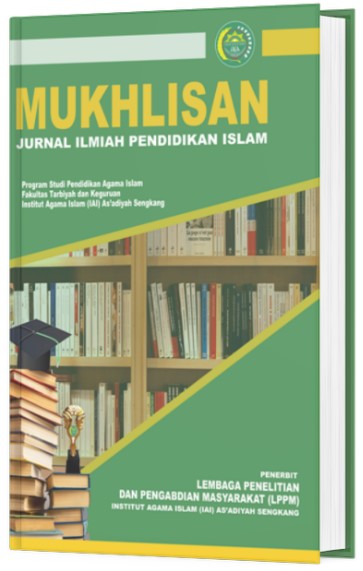BLENDED APPROACHES A MIXED-METHODS STUDY OF 10TH GRADE STUDENTS AT MAN 1 SAMARINDA
PENDEKATAN CAMPURAN STUDI METODE CAMPURAN PADA SISWA KELAS X MAN 1 SAMARINDA
Keywords:
Quranic studies, mixed-methods research, Islamic education, blended learning, madrasah educationAbstract
This mixed-methods study explores the effectiveness of integrated digital and traditional approaches in improving Quranic and Hadith learning out-comes among 10th-grade students at Madrasah Aliyah Negeri (MAN) 1 Samarinda. Both quantitative data from pre-test/post-test assessments (n=68) and qualitative insights from semi-structured interviews (n=15) were collected and analyzed. Results demonstrated a statistically signifi-cant improvement in learning outcomes after the implementation of the integrated approach (p<0.001), with a 27.6% increase in average assess-ment scores. Qualitative findings revealed increased student engagement, deeper understanding of textual contexts, and enhanced memorization abilities. The integration of digital applications with traditional memorization techniques created a synergistic learning environment that accommodated diverse learning styles. This study contributes to the growing body of knowledge on technology integration in Islamic religious education and offers practical recommendations for educators seeking to enhance Quranic and Hadith instruction within the Indonesian madrasah system.
References
Ahmad, M. K., & Rahman, S. F. A. (2022). Digital transformation in Islamic education: Opportunities and challenges in Southeast Asian contexts. Journal of Islamic Education, 45(3), 217-235.
Al-Farabi, N., & Ibrahim, H. (2021). Memorization techniques for Hadith studies: Integrating classical methods with modern technology. International Journal of Islamic Education Studies, 9(2), 143-162.
Aziz, A. A., Hassan, F., & Ibrahim, M. A. (2023). Student engage-ment and performance in Quranic studies: A comparative anal-ysis of traditional and technology-enhanced learning ap-proaches. Religious Education Journal, 38(1), 76-92.
Fawziah, S., & Lukman, H. (2021). The impact of educational tech-nology on Islamic studies curriculum: A case study of Indone-sian madrasahs. Journal of Education and Religious Studies, 12(4), 412-427.
Hamid, R., Ismail, A., & Abdullah, M. (2022). Technological chal-lenges in implementing digital learning in rural Islamic schools of Indonesia. International Journal of Educational Technology, 15(2), 83-99.
Jannah, M., & Rasyid, A. (2022). Student perceptions of blended learning in Quranic memorization: A mixed-methods analysis. Islamic Education Technology Journal, 7(3), 203-219.
Mahmood, T., & Rahman, A. (2021). Teacher attitudes toward tech-nology integration in religious education: A comparative study of traditional and progressive madrasahs. Teaching and Teacher Education in Islamic Contexts, 29(4), 356-371.
Nuraini, K., & Fauzan, A. (2021). Cultural preservation concerns in digitizing Islamic education: Perspectives from Indonesian reli-gious scholars. Journal of Religion and Technology, 18(2), 127-143.
Pratama, H., & Saleh, M. (2023). Effectiveness of mobile applica-tions in enhancing Hadith understanding among secondary school students. Mobile Learning in Religious Education, 14(1), 42-59.
Rahman, F., & Abdullah, K. (2020). Integration of technology in Is-lamic studies: Impact on student achievement and engage-ment. Technology, Pedagogy and Education in Islamic Con-texts, 19(3), 278-294.
Rohmah, N., & Hassan, Z. (2022). Balancing tradition and innovation in Islamic education: Perspectives of educators in Indonesian madrasahs. International Journal of Religious Education, 33(2), 178-195.
Safar, A. H., & Saleh, M. A. (2023). Digital literacy among Islamic studies teachers: Challenges and opportunities. Journal of Teacher Development, 27(1), 53-68.
Sulaiman, A., & Ismail, R. (2021). Spaced repetition and digital flashcards in Quranic memorization: A quasi-experimental study. Learning and Instruction in Religious Contexts, 31(4), 389-405.
Wahid, F., & Ahmad, T. (2022). Visualization tools for understanding Quranic context: Impact on student comprehension and reten-tion. Educational Technology Research and Development, 70(2), 621-639.
Yusuf, M., & Hassan, A. (2021). The role of teacher training in suc-cessful technology integration in religious education. Journal of Digital Learning in Teacher Education, 37(3), 234-249.
Zainuddin, H., & Halili, S. H. (2022). Student engagement in blended learning environments: A study of Quranic and Hadith educa-tion in Indonesian madrasahs. Interactive Learning Environ-ments, 30(1), 118-134.
Zulkifli, Z., & Ibrahim, M. S. (2023). Parental perspectives on tech-nology use in Islamic education: A qualitative study in East Ka-limantan, Indonesia. Family Involvement in Religious Educa-tion, 16(2), 145-161.
Downloads
Published
How to Cite
Issue
Section
License
Copyright (c) 2025 Muhammad Rizky Fadillah, Hidayat

This work is licensed under a Creative Commons Attribution-ShareAlike 4.0 International License.








